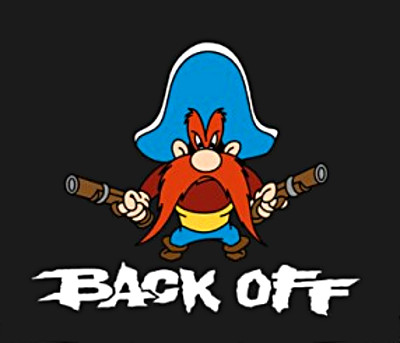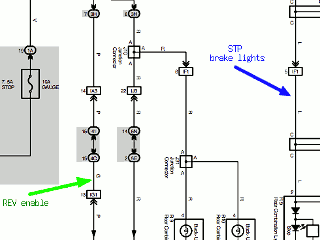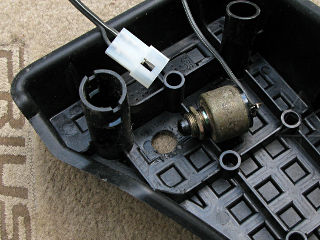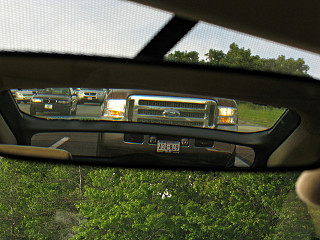It is a simple wiring hack that when triggered, lights all the bright lamps on the rear of the car at once. *All* of them. It provides an attention-getting signal using only the stock, DOT-approved illumination devices from the factory, to help alert following drivers to a potentially hazardous or improper condition. An abrupt and unusual pattern of lights attempts to signal a driver to wake up, put down the phone, and pay attention to focus completely on the situation at hand. Maybe it's something minor, like turning off the high beams. But in the majority of cases, the safest course of corrective action includes slowing down and/or backing away to increase following distance, and is indeed the usual real-life usage intent as aggressive tailgating and dangerously close vehicle proximity has gotten ridiculously out of control on our roads these days.
The Yuppie Button is an essential piece of safety equipment.
Ask almost anyone what they think when other drivers get up too close behind them and fill the rear-view with grille. Many will respond with "ooh, I *hate* the tailgaters. It's so dangerous. Especially from trucks." If they've ever been rear-ended they may be even more sensitive to it, but probably still feel that the matter is out of their control and that they can only hang on and hope the adversarial bogey on their six eventually passes or turns off. But we can never count on that and it's a situation that should never occur in the first place, never has the existing laws against it enforced, so long ago I decided to *do* something about it on my own.

As amusingly presented as Sam's message is here, on mud flaps or a bumper sticker it is far too passive. A strong means of interactive, immediate communication is needed to make any impression on our cellphone-addicted, TV-culture populace with zero attention span nowadays, or they just don't get it. This article details the early motivation and development of the project, the specifics on how it's done in a Prius and some subsequent improvements, and some usage and philosophy musings based on real-world experience on the road.
History
This is not a new idea. While not necessarily aimed at best fuel-efficiency techniques at the time, my driving style became quite mellow over the early years of its development and I often felt a need to at least warn drivers coming up behind that something was different -- maybe I *wasn't* accelerating as hell-bent out of a side road as they thought I might be. The worst offenders were, in the common parlance of the day, the yuppies in their Bimmers with running delusions of demanding Autobahn-like performance on our stodgy local roads. The common street wisdom of lightly tapping the brake pedal in the classic "brake check" maneuver seemed like anything but a wise course of action because the intent was for the *other* party to slow down, not me. A flick or two of the stock hazard flashers didn't carry nearly the desired impact and would also show to the front, so something better was clearly needed. With the name of the modification already chosen, in the early nineties I tore into the wiring harness of my Trooper to make it happen.
That was a thorough job -- the truck's entire rear wiring harness passed through the cabin interior right between the seats in a couple of convenient bundles, giving easy access, and I did a complete front-to-back split of the turn signal lines and running lights along with the other changes. The trigger switch was stealthed deeply away into a steering column bracket so that a finger had to be inserted through just the right way to reach it. When activated, a nice loud *clack* would be heard as three relays snapped over at once in a tidy box mounted up under the dash.
And it worked. Even in those days before universal third-eye brake lights and ordinary slow lamps instead of LEDs, I'd fire it at some car screaming up too fast behind me and see a satisfactory change in velocity -- sometimes abrupt enough to produce a little nosedive, which told me that they hadn't really been paying that much attention and would have gotten a lot closer if nothing unusual had happened. Already I could see the merits of this as a safety feature, and there were quite a few occasions when I'd see a highway slowdown way ahead of me and start laying into the thing to better warn traffic behind that something odd was up.
I liked the low-key approach from the beginning. People I've described the concept to would sometimes brighten up and reel off stories like "wanna know what my uncle did? He mounted two big FOG LIGHTS on the back bumper, and any time someone came up and tailgated him, WHAMMO!" Well, there's a fuzzy line somewhere between safe, effective, and obnoxious, and as tempting as it might sometimes be to completely blind an interloper to the rear, the intent here is notification rather than injury. Plus, they have their nice factory-installed and entirely legal high beams to fight back with.
The trusty but fatally rusting ol' Trooper was succeeded a decade-plus later by the Subaru wagon, which I didn't really like all that much but knew it was a sort of temporary, interim solution anyway. It hauled its share of gear and made some long trips, but it didn't get this extent of mod -- only a couple of simple hacks were done on it but investigating those also made me more aware that automotive electrics were radically changing over the years. Then the Prius came along, opening up whole new worlds with fascinating combinations of technologies to study and realizations on what that driving style I had evolved over years was best suited for: hypermiling, for some sensible value of it, with emphasis on its combined beneficial goals of improved safety and efficiency.
At the same time it seemed that as the internet rose steeply into ubiquity, that driver behavior and attitudes in this country had followed an opposite but equally precipitous dive, all over only ten or fifteen years. 9/11 didn't help, because then you had millions of people plastering little yellow-ribbon stickers onto their cars and reaffirming their god-given all-American right to be pushy on the roads and waste as much fuel as they wanted -- certainly a strange reaction to learning in a particularly poignant way that for that privilege we were sending lots of money to nations that hate us, and inexplicably taking out that frustration on *our own countrymen*. Nonetheless, this idiotic game of antagonistic jungle superiority received the enthusiastic backing of the auto companies, cranking out plenty of big, high-markup trucks and SUVs and selling even more of the speed-and-power myth than ever. Each new improvement in engine technology that hit the news maybe gave a token nod to fuel efficiency but for the most part all that new tech was hailed as giving the motoring public MORE POWER. Couple that with an insanely misdirected and government-agency backed manufacturing focus on mitigating the effects of a crash instead of preventing the crash in the first place, and you still have a socially deadly combination all in the name of "freedom". When people are out shopping for vehicles based on how many *airbags* they include, the whole system is tragically broken.
My non-abrupt driving style, backed by the "orbital mechanics" calculations for a relatively minimal energy-envelope needed to go from A to B, was and still is the total antithesis of that. Let it be immediately clear that this does *not* mean being the slowest car on the road leading a long and frustrated parade -- any loaded truck will usually take that honor, especially in the hills. My approach is simply a little different behavior on the "shoulders" of starts and stops and the light-to-light shuffle, leaving generous space ahead, and effective wave damping in traffic congestion. If anything, it frequently gets me *and* several other people where we're collectively going sooner overall, but they don't understand why or how. Fortunately I discovered that I was no longer alone in these efforts, also thanks to the internet and a bit of a resurgence of interest in energy-saving science and lifestyles as well as other car enthusiasts now treading the path of sipping rather than guzzling fuel. Now I could commiserate with my Prius-owner and MPG-aficionado buddies, swapping our sad stories from the road. The attacks from the rear kept getting more frequent and downright nastier for even less reason, as though tooling along at or ABOVE a local speed limit and almost always in the right-hand lane when present wasn't good enough and was somehow still interfering with the supposed rights of traffic behind to go faster. I would also get it from large trucks, whose drivers I used to trust as polite and professional on long night-time drives back in the day but now seemed to behave more like axe-murderers. "Road rage" was all over the news. Even some of the nicest people I personally knew would turn into total animals when they got behind the wheel.
While tailgating and aggressive behavior is hardly a right but rather a blatant abuse of a granted privilege, how about *my* right to safe, orderly travel without being continually threatened with real, physical danger from other road users? Especially those wielding the 40-ton sledgehammers? Clearly, the Yuppie Button needed to make a comeback. Maybe as a Flaming Asshole Button this time, but that doesn't flow quite the same way.


